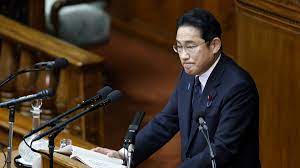As poll numbers decline, Japan’s Kishida unveils a $113 billion stimulus
In an attempt to combat inflation and save his premiership, Japanese Prime Minister Fumio Kishida unveiled a stimulus plan costing more than $100 billion on Thursday. Kishida’s poll numbers are at an all-time low. Since Russia began its invasion of Ukraine last year, voters in the third-largest economy in the world have been severely impacted by increasing prices, which has increased energy expenses and placed pressure on the government.
At a meeting, Kishida said, “We are seeing that the tide is turning from the vicious cycle of deflation — symbolised by low prices, low wages, and low growth.” He also disclosed that the package will be around 17 trillion yen ($113.2 billion) in value.
He then on, “We have a fantastic opportunity to enter a new economic stage for the first time in thirty years.” “However, in order to prevent a return to deflation, it is necessary to support people’s disposable income temporarily in the current situation where the rise in wages is not keeping up with the rise in prices,” he said.
Further data from the government were anticipated later, although sources suggested that the program’s total estimated value, including expenditure from the private sector, was 37.4 trillion yen. According to public broadcaster NHK and other local media, the proposal includes cash transfers of 70,000 yen to low-income families, as well as reductions in income and residential taxes of 40,000 yen per person.
Additionally, fuel subsidies would be prolonged, and money will be available to encourage investments in high-tech sectors like the semiconductor and space industries. The package is expected to contribute to Japan’s already high level of debt—which was 261 percent of GDP in 2022—among the highest in the world.
After the Covid-19 outbreak, the government has already spent hundreds of billions of dollars to boost the economy. Although the GDP grew by 1.2 percent from April to June, it has been gradually increasing, and it is predicted to have decreased subsequently.
For many decades, Japan had deflation; but, similar to other global economies, with the start of the Ukraine conflict in February 2022, prices have increased. While good news for Japanese exporters, a lower yen drives up import prices and increases household inflation.
In contrast to other significant central banks, the Bank of Japan has resisted the need to tighten monetary policy and has instead kept bond yields very low and interest rates below zero in an effort to promote economic development. This has happened despite the fact that inflation is still rising and the core consumer price index is at a three-decade high. Officials have increased their projections for this year and next, but they maintain the increase is only temporary.
However, its position has increased pressure on the yen, which is among the main currencies with the poorest performance globally in 2023. Kishida’s popularity is at its lowest point since taking government two years ago, partly due to voter discontent with inflation.
Kishida, 66, is eligible to continue in office until 2025, but there has been conjecture that he may call an early election in order to avoid the difficult internal party leadership contest that his Liberal Democratic Party (LDP) is expected to have next year. Chief economist of Dai-ichi Life Research Institute Hideo Kumano expressed his “skepticism” about the package’s ability to support the prime minister or the economy.
According to AFP, Kishida has wavered between emphasizing economic restraint and wanting to increase expenditure. “Kishida wasn’t backed by those who had opposed any tax increase to fund government policies. Those who had objected to giving money out liberally would now abandon him, the expert told AFP. The electorate must be persuaded.
However, 74-year-old Masaharu Kashima told AFP in Tokyo: “I have no choice but to look for cheaper items because everyday products have become more expensive.” I now only buy half as much.I doubt that there will be much of a shift in the stimulus. Additionally, they previously offered us 100,000 yen (during COVID), but nothing changed.







